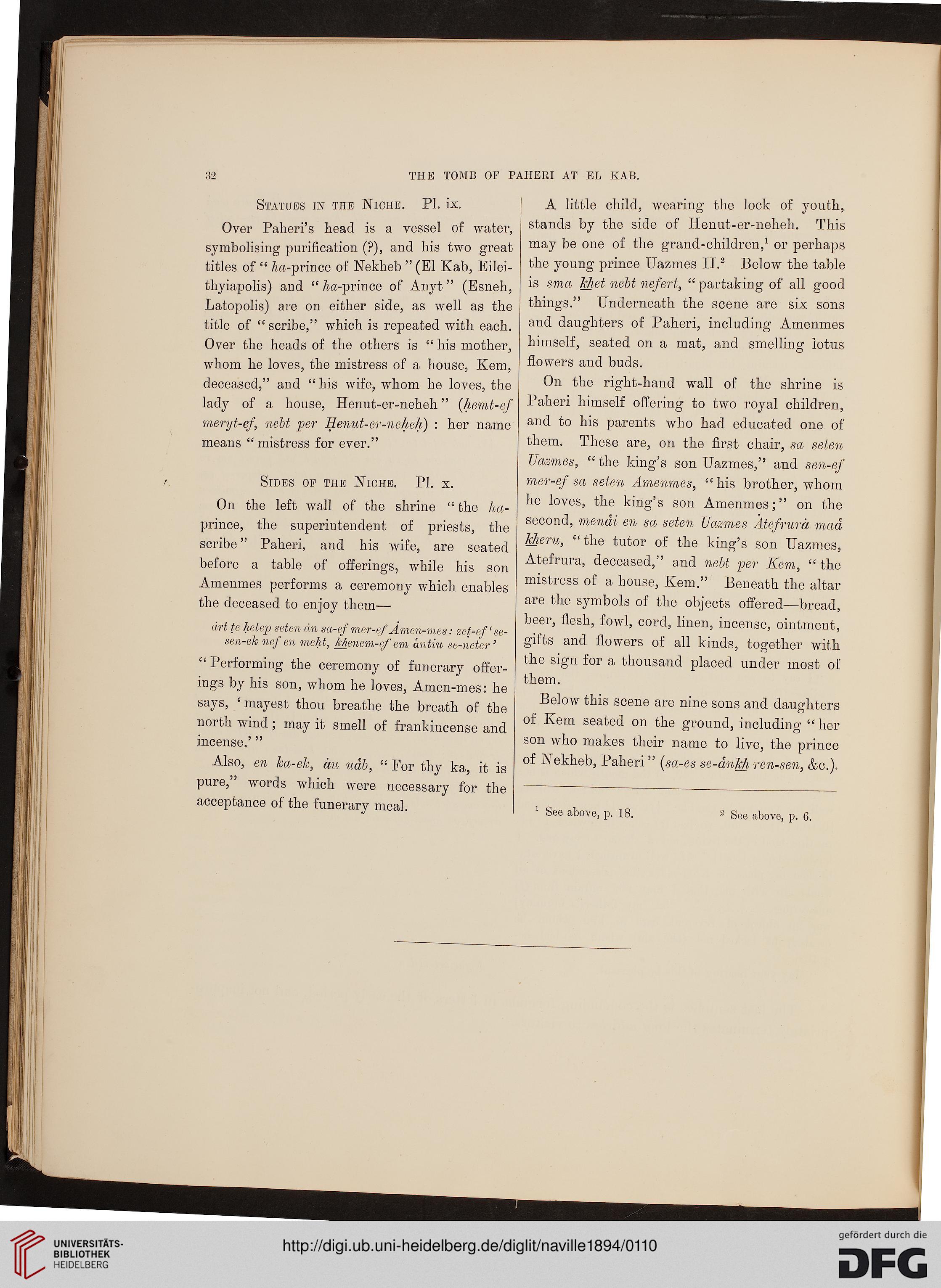32
THE TOMB OF PAHERI AT EL KAB.
f,
Statues in the Niche. PL ix.
Over Paheri's head is a vessel of water,
symbolising purification (?), and his two great
titles of " /m-prince of Nekheb " (El Kab, Bilei-
thyiapolis) and " ha-prince of Anyt" (Esneh,
Latopolis) are on either side, as well as the
title of " scribe," which is repeated with each.
Over the heads of the others is " his mother,
whom he loves, the mistress of a house, Kem,
deceased," and " his wife, whom he loves, the
lady of a house, Henut-er-neheh" (hemt-ef
meryt-ef, nebt per Henut-er-neheh) : her name
means " mistress for ever."
Sides of the Niche. PI. x.
On the left wall of the shrine " the ha-
prince, the superintendent of priests, the
scribe" Paheri, and his wife, are seated
before a table of offerings, while his son
Amenmes performs a ceremony which enables
the deceased to enjoy them—
art te hetep seten an sa-ef mer-ef Amen-mes: zet-ef'se-
sen-elc nef en meht, kkenem-ef em antiu se-neter'
" Performing the ceremony of funerary offer-
ings by his son, whom he ]oves, Amen-mes: he
says, 'mayest thou breathe the breath of the
north wind; may it smell of frankincense and
incense.' "
Also, en ka-eh, cm udb, " For thy ka, it is
pure," words which were necessary for the
acceptance of the funerary meal.
A little child, wearing the lock of youth,
stands by the side of Henut-er-neheh. This
may be one of the grand-children,1 or perhaps
the young prince Uazmes II.2 Below the table
is sma Met nebt nefert, " partaking of all good
things." Underneath the scene are six sons
and daughters of Paheri, including Amenmes
himself, seated on a mat, and smelling lotus
flowers and buds.
On the right-hand wall of the shrine is
Paheri himself offering to two royal children,
and to his parents who had educated one of
them. These are, on the first chair, sa seten
Uazmes, " the king's son Uazmes," and sen-ef
mer-ef sa seten Amenmes, " his brother, whom
he loves, the king's son Amenmes;" on the
second, mendi en sa seten Uazmes Atefvuva mad
Mem, " the tutor of the king's son Uazmes,
Atefrura, deceased," and nebt per Kem, " the
mistress of a house, Kem." Beneath the altar
are the symbols of the objects offered—bread,
beer, flesh, fowl, cord, linen, incense, ointment,
gifts and flowers of all kinds, together with
the sign for a thousand placed under most of
them.
Below this scene are nine sons and daughters
of Kem seated on the ground, including " her
son who makes their name to live, the prince
of Nekheb, Paheri " (sa-es se-dnM vein-sen, &c).
See above, p. 18.
See above, p. 6.
THE TOMB OF PAHERI AT EL KAB.
f,
Statues in the Niche. PL ix.
Over Paheri's head is a vessel of water,
symbolising purification (?), and his two great
titles of " /m-prince of Nekheb " (El Kab, Bilei-
thyiapolis) and " ha-prince of Anyt" (Esneh,
Latopolis) are on either side, as well as the
title of " scribe," which is repeated with each.
Over the heads of the others is " his mother,
whom he loves, the mistress of a house, Kem,
deceased," and " his wife, whom he loves, the
lady of a house, Henut-er-neheh" (hemt-ef
meryt-ef, nebt per Henut-er-neheh) : her name
means " mistress for ever."
Sides of the Niche. PI. x.
On the left wall of the shrine " the ha-
prince, the superintendent of priests, the
scribe" Paheri, and his wife, are seated
before a table of offerings, while his son
Amenmes performs a ceremony which enables
the deceased to enjoy them—
art te hetep seten an sa-ef mer-ef Amen-mes: zet-ef'se-
sen-elc nef en meht, kkenem-ef em antiu se-neter'
" Performing the ceremony of funerary offer-
ings by his son, whom he ]oves, Amen-mes: he
says, 'mayest thou breathe the breath of the
north wind; may it smell of frankincense and
incense.' "
Also, en ka-eh, cm udb, " For thy ka, it is
pure," words which were necessary for the
acceptance of the funerary meal.
A little child, wearing the lock of youth,
stands by the side of Henut-er-neheh. This
may be one of the grand-children,1 or perhaps
the young prince Uazmes II.2 Below the table
is sma Met nebt nefert, " partaking of all good
things." Underneath the scene are six sons
and daughters of Paheri, including Amenmes
himself, seated on a mat, and smelling lotus
flowers and buds.
On the right-hand wall of the shrine is
Paheri himself offering to two royal children,
and to his parents who had educated one of
them. These are, on the first chair, sa seten
Uazmes, " the king's son Uazmes," and sen-ef
mer-ef sa seten Amenmes, " his brother, whom
he loves, the king's son Amenmes;" on the
second, mendi en sa seten Uazmes Atefvuva mad
Mem, " the tutor of the king's son Uazmes,
Atefrura, deceased," and nebt per Kem, " the
mistress of a house, Kem." Beneath the altar
are the symbols of the objects offered—bread,
beer, flesh, fowl, cord, linen, incense, ointment,
gifts and flowers of all kinds, together with
the sign for a thousand placed under most of
them.
Below this scene are nine sons and daughters
of Kem seated on the ground, including " her
son who makes their name to live, the prince
of Nekheb, Paheri " (sa-es se-dnM vein-sen, &c).
See above, p. 18.
See above, p. 6.




